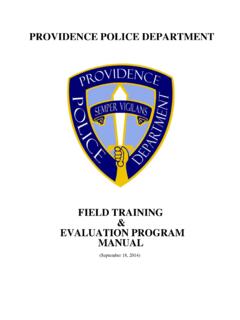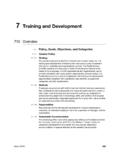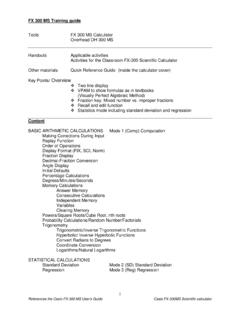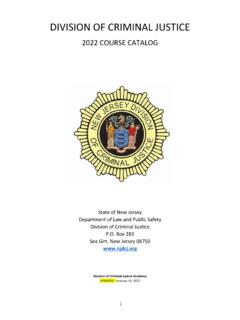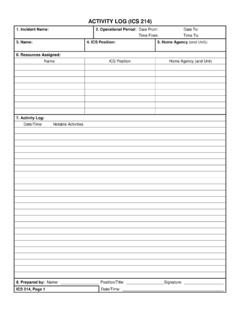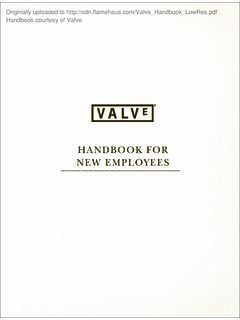Transcription of Leader’s Guide to Objective Assessment of Training Proficiency
1 15 March 2017 Leader s Guide to Objective Assessment of Training Proficiency Informally referred to as the Army s Objective -T initiative, these procedures outline how leaders and units objectively assess and record Training Proficiency IAW FM 7-0, Train to Win in a Complex World. To correctly implement the procedures outlined in this Guide , leaders should start with a full understanding of the basic, doctrinal procedures found in FM 7-0. This Leader s Guide supports FM 7-0 and serves as interim instruction to assist leaders in understanding and implementing the Objective Assessment and recording of Training proficiencies. HQDA G/3/5/7 Department of the Army 2 [This leader s Guide is formatted to optimize 2-sided printing] The proponent for the Leader s Guide : Objective Assessment of Training Proficiency is the Department of the Army.
2 The preparing agency is the Training Management Directorate (TMD) within CAC Training (CAC-T). CAC T is subordinate to the United States Army Combined Arms Center. TMD is the Army proponent for Training management. Send comments through the Army Training Network (ATN) at using the Ask-A-Trainer feature and using the term LG to Assessment in the subject line. Leader s Guide to Objective Assessment of Training Proficiency March 2017 3 Table of Contents Foreword Chapter 1 Introduction to Training Proficiency Chapter 2 Assessing Training Proficiency SECTION I Individual, Crew Served and Platform Proficiency SECTION II Mission-Essential Task Proficiency SECTION III Collective Live-Fire Task Proficiency SECTION IV Training Days Chapter 3 Recording Training Proficiency Chapter 4 Reporting Training Readiness Appendices A.
3 Terms of Reference B. Operational Environment (OE) C. Individual/Crew Served/Platform Proficiency Tables D. Collective Live-Fire Gates E. Unit Training Proficiency Report F. Training and Evaluation Outlines References J l ANDERSON -, HAR I 5 !OilLieutenant General, GS Deputy Chief of Staff, G-3/5/7 4 Foreword This Leader s Guide provides procedural instructions in support of Army Directive 2016-05 (Building Training Readiness), HQDA EXORD 002-16 (Enable, Resource, Build, Assess, and Sustain Training Readiness), FRAGO 1 to EXORD 002-16, and FRAGO 2 to EXORD 002-16. The Guide serves as a bridging document for AR 220-1 (Army Unit Status Reporting and Force Registration Consolidated Policies), AR 350-1 (Army Training and Leader Development), their associated DA PAMs, and FM 7-0. Where there are differences between AR 220-1, AR 350-1, and FM 7-0 and the procedures stated in the Leader's Guide to Objective Assessment of Training Proficiency , the Leader's Guide has predominance.
4 The Leader's Guide provides prescriptive guidance in the interim until these other publications are revised and updated. It applies Army wide unless otherwise stated. I encourage you to read FM 7-0, Train to Win in a Complex World. As leaders, our responsibility is to properly plan, prepare, execute, and assess Training to ensure our Soldiers are prepared for combat. Training readiness informs senior leaders and supports their decisions regarding the distribution of a wide variety of resources, to include time, money, and For additional information and supporting documentation please visit the Army Training Network If you have additional questions contact yourUSR reporting POCs, as well as your chain of command. Leader s Guide to Objective Assessment of Training Proficiency 15 March 2017 Leader s Guide to Objective Assessment of Training Proficiency March 2017 5 Chapter 1 Introduction to Training Proficiency This chapter provides an overview and background to the Army s effort to make the evaluation, Assessment and recording of Training Proficiency more Objective .
5 This in turn provides the fundamental basics of how units report the foundational components of Training Readiness in the Commanders Unit Status Report. Introduction 1-1. Training is the cornerstone of readiness. Readiness determines our Nation s ability to fight and win in a complex world. To achieve and maintain a high degree of readiness, the Army trains in the most efficient and effective manner possible. Realistic Training with limited time and resources demands commanders focus their unit Training efforts to maximize Training Proficiency . Evaluating, assessing, recording, and reporting unit Training Proficiency and Training readiness requires Army Leaders to have a firm understanding of the Training fundamentals established by FM 7-0, Train to Win in a Complex World.
6 1-2. The purpose of this Guide is to detail the procedures for Army leaders to objectively and accurately evaluate, assess, record, and report the four Foundational Components of Training Readiness. It applies to all Army readiness reporting units. This Guide serves as a baseline and prescriptive tool for unit leaders as they assess unit Training Proficiency . Where there are differences between AR 220-1, AR 350-1, and FM 7-0 and the procedures stated in the Leader's Guide to Objective Assessment of Training Proficiency , the Leader's Guide has predominance. The Leader's Guide provides prescriptive guidance in the interim until AR 220-1, AR 350-1 and FM 7-0 are revised and updated. Background 1-3. The Army needs a disciplined and Objective linkage between assessing Training Proficiency and reporting Training readiness.
7 This Guide addresses Objective evaluation criteria to prevent over-weighted subjective task assessments, in order to provide a more complete and accurate report of actual unit capabilities and readiness. This Guide addresses effects of over a decade of Leader s Guide to Objective Assessment of Training Proficiency March 2017 6 unit deployments and persistent combat operations, which contributed to leaders diminished understanding and employment of sound, fundamental unit driven Training doctrine and procedures. Figure 1-1. Process of assessing Training Proficiency and reporting Training Readiness Linking Training Proficiencies to Training Readiness1-4. Units train to achieve and sustain Training proficiencies. Proficiencies are directly related to the unit s Training readiness as reflected in the T-level rating as defined by AR 220-1.
8 This Leader s Guide provides the metrics and how-to for translating the unit s Training proficiencies into the unit s Training readiness level. 1-5. Training Proficiencies are the measure of individuals, crews, and units ability to perform their Training tasks to standard. For individual and crew tasks, the Army proponent for the task defines the standards and the ratings for measuring task Proficiency . For all Army collective tasks, the task s T&EO contains the standards and the Proficiency ratings. Select Training proficiencies are used for readiness reporting purposes and are outlined in this Guide . 1-6. The T-level Rating is an Assessment of the unit s ability to provide the capabilities for which it was designed based upon a composite Assessment of the four foundational components of Training readiness.
9 assigned Mission Training (AMT) Level is a reflection of the Commanders Assessment of the units Training Proficiency to provide the capabilities required to accomplish its assigned mission as determined by the Army Tasking Authority. Components of Training Readiness 1-7. There are four foundational components of Training readiness. , Crew Served, and Platform Proficiency conducted IAWappropriate doctrinal reference (TRADOC proponent Centers of Excellence promulgate qualification standards by weapon system) with three categories: Individual, Crew Served, and Platform (I/CS/P). Qualified or Unqualified are the Training Proficiency measures used for the reporting of these proficiencies. Task (MET) Proficiency demonstrated throughevaluation of collective task Proficiency during Training events IAW MET Training and Evaluation Outlines (T&EO).
10 Leader s Guide to Objective Assessment of Training Proficiency March 2017 7 c. Collective Live-Fire Task Proficiency demonstrated through evaluation of collective task Proficiency under live-fire conditions IAW Training and Evaluation Outlines (T&EO). The Commander two levels above the echelon of measured Proficiency determines the collective task(s) that will be performed/evaluated under live-fire conditions. The collective live-fire task(s) are performed during the live-fire gate specified for the unit in Appendix D. d. Training Days (T-Days) The Commander s estimate of the minimum number of continuous Training days, unconstrained by resources, required to achieve T1. T-Days is derived from the approved unit Training plan (UTP) and refined through commanders dialogue.

